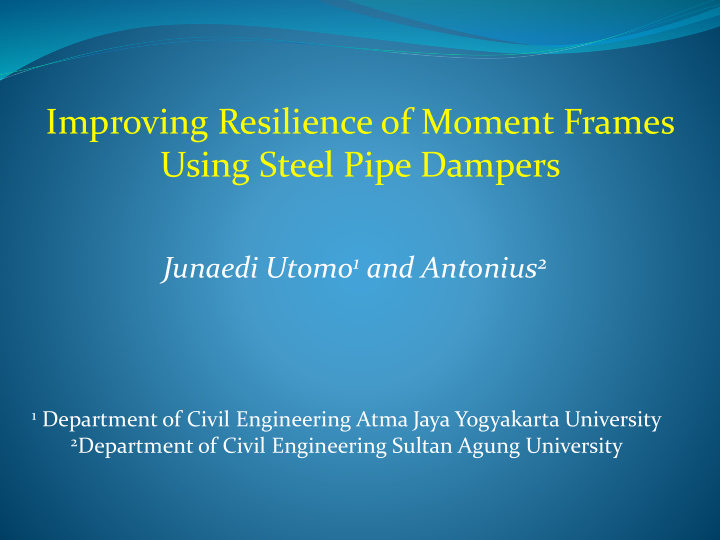



Improving Resilience of Moment Frames Using Steel Pipe Dampers Junaedi Utomo 1 and Antonius 2 1 Department of Civil Engineering Atma Jaya Yogyakarta University 2 Department of Civil Engineering Sultan Agung University
Outline of the Presentation 1. Introduction 2. Steel pipe dampers 3. Passive energy dissipation systems - Damper configuration and earthquake time histories - Results of the simulation study 4. Improving physical resilience of moment resisting frames 5. Conclusion
Introduction Earthquake resiliency of moment resisting frames, either new or existing ones, are important for maintaining their functionality. Steel pipe dampers are capable to dissipate most of the earthquake energy in structures through inelastic deformation so that other components of the structures are protected. Steel pipe dampers, when installed at strategic locations in the moment frame structures, can be used to improve earthquake resiliency of moment resisting frames.
Steel Pipe Dampers Steel pipes are chosen as the basic material for seismic dampers because: 1. Pipes have excellent inelastic deformation capability. 2. Pipes are cheap and require low workmanship.
Vertical Steel Pipe Dampers
Passive energy dissipation systems (Christopoulos, C. and Filliatrault, A. (2006))
Damper configuration and earthquake loading
Damper configuration This configuration is used to minimize the effect of axial forces.
Steel pipe dampers yield when they dissipate input earthquake energy in structures. Yielding steel pipe dampers loose most of their stifnesses. Steel pipe dampers are weak axially when they yield.
Earthquake time histories North-South components of the following earthquakes will be used in numerical simulation. 1. El-Centro (California), 1940. 2. Fukushima-Hamadori (Japan), 2011 3. Padang (west Sumatra), 2009 4. Chi-Chi (Taiwan), 1999. Peak Ground Acceleration of the three other earthquakes were scaled down to El-Centro 1940.
Result of the simulation study
Four steps in the numerical study of the damper application: 1. Determine the basic frame structure. 2. Select the earthquake time histories used in the numerical simulation. 3. Determine the required number of dampers at each story. 4. Evaluate the effectiveness of seismic protection in the frame structure with dampers installed.
(a) (b) Inter-story drift due to four earthquakes: (a) Frame without dampers and (b) Frame with dampers
Dissipated inelastic energy in kN.m (along H1)
Time history of energy dissipation due to four earthquakes
Improving physical resilence of moment resisting frames Hazards (corrosion induced damages and earthquakes) pose continuing and significant threats to structures by reducing the capability to withstand the effect of seismic event and to recover efficiently the original functionality of the structures.
Fragility curves (b) (a) Effects of resourcefulness and recovery phase on fragility curve: a) Functionality; b) Fragility curve
Conclusion The use of steel pipe dampers improves the resiliency (reduces the overall earthquake response) of the moment frames, the installation of steel pipe dampers increases story shears, member forces around the dampers and floor accelerations.
Recommend
More recommend